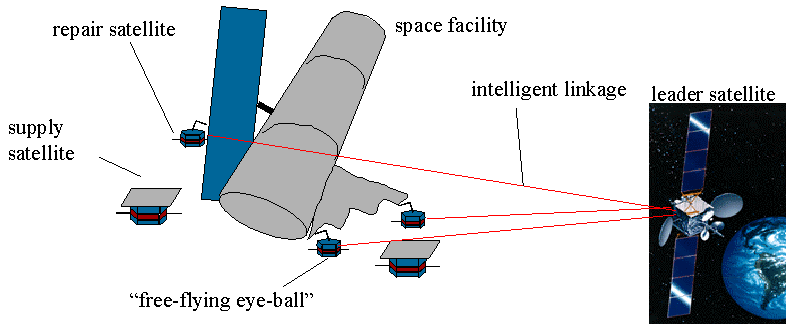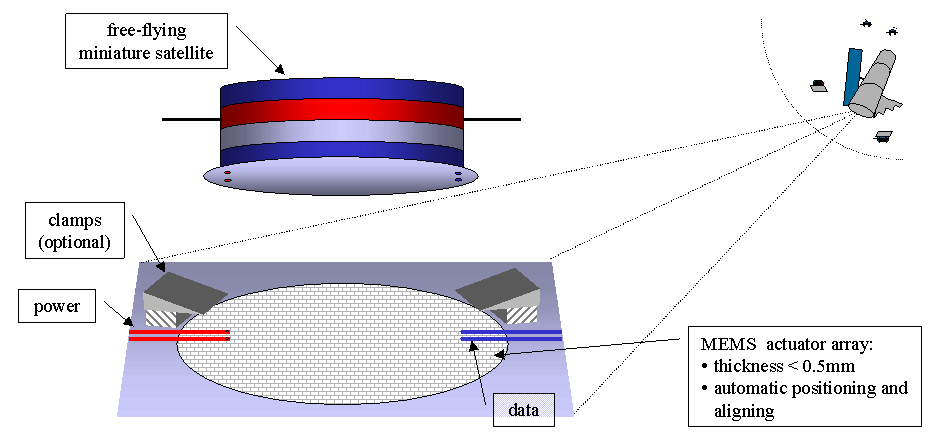Projects Archive
Picosatellite Docking with MEMS Ciliary Arrays - Smart Attachments for Spacecraft (1999-2002)
Team Members
Joel Reiter, M. Terry, Karl F. Böhringer, R. Bruce Darling
David Meller, Mark Campbell (Aeronautics & Astronautics)
John W. Suh, Greg T. A. Kovacs (Stanford)
Summary
Miniaturized spacecraft offer exciting new possibilities for low-cost future space applications, such as large antenna arrays for communications, Earth and space science, defense and intelligence, and free-flying cameras that supervise the repair or construction of space facilities. However, they also pose significant challenges: their energy supply, communications and data storage capabilities, and memory for mission control software will be very limited. Thus, phases of free flight may be interrupted regularly by docking phases for recharging, data exchange, or reprogramming. A reliable docking system is essential for efficient operation. Key requirements for the docking mechanism include:
-
minimal size, weight, and hardware requirements,
-
reliable electrical connections for recharging and refueling, and
-
low cost.
Our goal is to achieve reliable docking for small satellites without the need for large mechanical structures such as catchers or chamfers. We propose a robust, lightweight, precise, and low-cost docking system for miniature spacecraft. In this project, we conduct a thorough analysis of the system requirements and build a proof-of-concept system that demonstrates the feasibility of our concept.
Our design takes advantage of recent advances in microelectromechanical systems (MEMS) which allow batch fabrication of thousands of devices in a single fabrication run on a silicon wafer. The system is based on microactuator arrays that have been developed in our group over the past six years, and that have already gone through several iterations of design improvements and thorough testing. The MEMS actuators create an "active surface" that is densely covered with hundreds or thousands of microscopic "cilia," each of them only a quarter millimeter in size. Operated together, these actuators are capable of precise positioning tasks with micrometer resolution. They have already been used in successful demonstrations of precision positioning under optical and scanning electron microscopes (air or vacuum as ambient medium).
The MEMS docking device will achieve the fine positioning after the miniature spacecraft have made contact with the docking site. For the device to be useful, it must be integrated into a complete system that can achieve the coarse positioning during the free-flight phase of the docking approach. Navigation and control strategies for this phase must be sufficient to bring the spacecraft into contact with positioning errors of less than a few inches. This goal of this project is an end-to-end docking system that fulfills these requirements.
 |
|
Figure 1: Free-flying miniature satellites (~1 kg) for inspection and repair of a space facility. Highly specialized micro-satellites are used to deliver supplies, perform robotic assembly, and collect or transmit video images. Requires frequent docking with other spacecraft to up/download data, reprogram, recharge batteries, refuel, deliver cargo, execute inspection / repair / construction missions. |
|
 |
|
Figure 2:Docking system for miniature spacecraft (conceptual design). A MEMS actuator array aligns the approaching micro satellite with the docking area. Magnets or clamps generate the required normal force. |
|
 |
|
Figure 3: Airtable experimental setup to simulate microsatellite docking. An 8" × 6" perforated aluminum plate with 3 adjustable support screws provides levitation support for an aluminum puck (‘picosat'). Microcilia chips are mounted on a vertical copper plate with heat sink. |
This work was listed among the "Top 100 Science Stories of 2002" in Discover magazine.
Video
Selected Publications
-
M. Terry, Joel Reiter, Karl F. Böhringer, John W. Suh, Gregory T. A. Kovacs, "A Docking System for Microsatellites Based on MEMS Actuator Arrays." IOP Journal of Smart Materials and Structures 10(6):1176-1184, December 2001. Paper.
-
David M. Meller, Joel Reiter, M. Terry, Karl F. Böhringer, Mark Campbell, "A Docking System for Microsatellites Based on MEMS Actuator Arrays." 42nd AIAA/ASME/ASCE/AHS/ASC Structures, Structural Dynamics, and Materials Conference & Exhibition, no. 2001-1504, Seattle, WA, April 16-19, 2001. Paper.
-
Joel Reiter, M. Terry, Karl F. Böhringer, John W. Suh, Gregory T. A. Kovacs, "Thermo-bimorph Microcilia Arrays for Small Spacecraft Docking." ASME International Mechanical Engineering Congress and Exposition (IMECE), Micro-electro-mechanical Systems (MEMS), vol. 2, pp. 57-63, Orlando, FL, November 5-10, 2000. Paper.
A complete list of our publications (many of them available online) can be found here.
Acknowledgements
-
DARPA/AFRL contract F29601-98-D-0210 - USRA subcontract 9500-20
-
NSF CAREER award ECS-9875367
